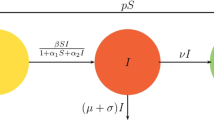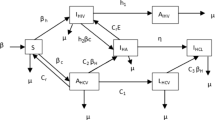Abstract
In this article, we have constructed a PI model with general incidence rate and humoral immunity. We have analyzed about the equilibrium points in general case. Using appropriate Lyapunov functional and Lasalle’s invariance principle, the global stability of the newly constructed model have been discussed. Using patient data we have discussed about the model numerically.


Similar content being viewed by others
References
Fauci, A.S.: HIV and AIDS: 20 years of science. Nat. Med. 9, 839–843 (2003)
Anderson, R.M., Gupta, S., May, R.M.: Potential of community—wide chemotherapy or immunotherapy to control the spread of HIV-1. Nat. Lond. 350, 356–359 (1991)
Anderson, R.M., May, R.M., Mclean, A.R.: Possible demographic consequences of AIDS in developing countries. Nature 332, 228–234 (1988)
Blower, S.M.: Behavior changes and stabilization of seroprevalence levels, correlation or causation. JAIDS 4, 920–923 (1991)
Blower, S.M., Hartel, D., Dowlatabadi, H., Anderson, R.M., May, R.M.: Sex, drugs & HIV: a mathematical model for New York City. Philos. Trans. R. Soc. Lond. B 331, 171–187 (1991)
Dietz, K., Hadeler, K.P.: Epidemiology models for sexually transmitted diseases. J. Math. Biol. 26, 1–25 (1988)
Jacquez, J.A., Simon, C.P., Koopman, J., Sattenspiel, L., Perry, T.: Modelling and analysis HIV transmission: the effect of contact patterns. Math. Biosci. 92, 119–199 (1988)
Koopman, J., Simon, C., Jacquez, J., et al.: Sexual partner selectiveness effects on homosexual HIV transmission dynamics. JAIDS 1, 486–504 (1988)
Le Pont, F., Blower, S.M.: The supply & demand dynamics of sexual behavior: implications for a heterosexual HIV epidemic. JAIDS 4, 987–999 (1991)
May, R.M., Anderson, R.M., Blower, S.M.: The epidemiology and transmission dynamics of HIV/AIDS. Daedalus 118(2), 163–201 (1989)
Blower, S.M., Medley, G.F.: Epidemiology, HIV & drugs: Mathematical models & data. Br. J. Addict. 87, 31–39 (1992)
Ray, M., Logan, R., Sterne, J.A., HIV-CAUSAL Collaboration et al.: The effect of combined antiretroviral therapy on the overall mortality of HIV-infected individuals. AIDS 24, 123–137 (2010)
Nakagawa, F., Lodwick, R.K., Smith, C.J., et al.: Projected life expectancy of people with HIV according to timing of diagnosis. AIDS 26, 335–343 (2012)
Archin, N.M., Vaidya, N.K., Kuruc, J.D., et al.: Immediate antiviral therapy appears to restrict resting CD4+ cell HIV-1 infection without accelerating the decay of latent infection. Proc. Natl. Acad. Sci. USA 109, 9523–9528 (2012)
Taiwo, B., Matining, R.M., Zheng, L., et al.: Associations of T cell activation and infl ammatory biomarkers with virological response to darunavir/ritonavir plus raltegravir therapy. J. Antimicrob. Chemother. 68, 1857–1861 (2013)
Janeway, C., Travers, P., Walport, M., Shlomchik, M.: Immunobiology: The Immune System in Health and Diseases. Garland Science, London (2006)
Carpenter, C.: Universal access to antiretroviral therapy: when, not if. Clin. Infect. Dis. 42, 260–261 (2006)
Calmy, A., Petoumenos, K., Lewden, C., Law, M., Bocquentin, F., Hesse, K., Cooper, D., Carr, A., Bonnet, F.: Combination antiretroviral therapy without a nucleoside reverse transcriptase inhibitor: experience from 334 patients in three cohorts. HIV Med. 8, 171–180 (2007)
Chiyaka, C., Garira, W., Dube, S.: Modelling immune response and drug therapy in human malaria infection. Comput. Math. Methods Med. 9, 143–163 (2008)
Culshaw, R.V., Ruan, S.G., Spiteri, R.J.: Optimal HIV treatment by maximising immune response. J. Math. Biol. 48, 545–562 (2004)
Ji, Y., Min, L.Q., Zheng, Y., Su, Y.M.: A viral infection model with periodic immune response and nonlinear CTL response. Math. Comput. Simul. 80, 2309–2316 (2010)
Li, M.Y., Shu, H.Y.: Global dynamics of a mathematical model for HTLV-1 infection of CD4+T cells with delayed CTL response. Nonlinear Anal. Real World Appl. 13, 1080–1092 (2012)
Song, X.Y., Wang, S.L., Dong, J.: Stability properties and Hopf bifurcation of a delayed viral infection model with lytic immune response. J. Math. Anal. Appl. 373, 345–355 (2011)
Wang, S.L., Song, X.Y., Ge, Z.H.: Dynamics analysis of a delayed viral infection model with immune impairment. Appl. Math. Model. 35, 4877–4885 (2011)
Wang, K.F., Wang, W.D., Liu, X.N.: Global stability in a viral infection model with lytic and nonlytic immune responses. Comput. Math. Appl. 51, 1593–1610 (2006)
Xie, Q.Z., Huang, D.W., Zhang, S.D., Cao, J.: Analysis of a viral infection model with delayed immune response. Appl. Math. Model. 34, 2388–2395 (2010)
Nakata, Y.: Global dynamics of a cell mediated immunity in viral infection models with distributed delays. J. Math. Anal. Appl. 375, 14–27 (2011)
Pawelek, K.A., Liu, S., Pahlevani, F., Rong, L.: A model of HIV-1 infection with two time delays: Mathematical analysis and comparison with patient data. Math. Biosci. 235, 98–109 (2012)
Wang, S.F., Zou, D.Y.: Global stability of in-host viral models with humoral immunity and intracellular delays. Appl. Math. Model. 36, 1313–1322 (2012)
Wang, Z.P., Xu, R.: Stability and Hopf bifurcation in a viral infection model with nonlinear incidence rate and delayed immune response. Commun. Nonlinear Sci. Numer. Simul. 17, 964–978 (2012)
Yous, N., Hattaf, K., Tridane, A.: Modeling the adaptive immune response in HBV infection. J. Math. Biol. 63, 933–957 (2011)
Zhu, H.Y., Luo, Y., Chen, M.L.: Stability and Hopf bifurcation of a HIV infection model with CTL-response delay. Comput. Math. Appl. 62, 3091–3102 (2011)
Zhu, H.Y., Zou, X.F.: Dynamics of a HIV-1 infection model with cell-mediated immune response and intracellular delay. Discret. Contin. Dyn. Syst. B 12, 511–524 (2009)
Deans, J.A., Cohen, S.: Immunology of malaria. Annu. Rev. Microbiol. 37, 25–50 (1983)
Hattaf, K., Lashari, A.A., Louartassi, Y., Yousfi, n: A delayed SIR epidemic model with general incidence rate. Electron. J. Qual. Theory Differ. Equ. 3, 1–9 (2013)
Ouifki, R., Witten, G.: Stability analysis of a model for HIV infection with RTI and three intracellular delays. BioSystems 95, 16 (2009)
Yang, X., Chen, L., Chen, J.: Permanance and positive periodic solution for the single species non autonomous delay diffusion models. Comput. Math. Appl. 32, 109–116 (1996)
LaSalle, J.P.: The Stability of Dynamical Systems, Regional Conference Series in Applied Mathematics. SIAM, Philadelphia, PA, USA (1976)
Acknowledgements
The financial assistance from UGC, BSR Fellowship, New Delhi is gratefully acknowledged.
Author information
Authors and Affiliations
Corresponding author
Appendix A
Appendix A
Now we consider the Lyapunov functional of the form,
where
and
Then the derivative of the Lyapunov functional is,
Since,
-
(i)
\(f(T^*,{V_I}^*){V_I}^* = \delta e^{m_1 \tau _1} I^* = \dfrac{c e^{m_1 \tau _1 + m_2 \tau _2}}{N \epsilon _p} {V_I}^*\),
-
(ii)
f(T, V) is strictly monotonically increasing with respect to T,
-
(iii)
f(T, V) is strictly monotonically decreasing with respect to V, and
-
(iv)
f(T, V)V is monotonically increasing with respect to V,
from the above discussion we get \(W'(t)\le 0\). Clearly \(W(t) =0\) iff \(T=T^*,I=I^*, V_I = {V_I}^*\) and \( V_{NI} = {V_{NI}}^*\). Let \(M_1\) be the largest invarient subspace of \(\{(T,I,V_I,V_{NI},B)| W'=0\}\). For each point in \(M_1\), we have \(V_I ' =0, V_{NI}' = 0\) and \(B = 0\), so \(M_1\) includes a unique point, the equilibrium \(E_1\). By using Lasalle’s invariance principle, \(E_1\) is globally asymptotically stable.
Rights and permissions
About this article
Cite this article
Divya, M., Pitchaimani, M. Analyzing on stability of HIV-PI model with general incidence rate. J. Appl. Math. Comput. 56, 269–287 (2018). https://doi.org/10.1007/s12190-016-1073-0
Received:
Published:
Issue Date:
DOI: https://doi.org/10.1007/s12190-016-1073-0




